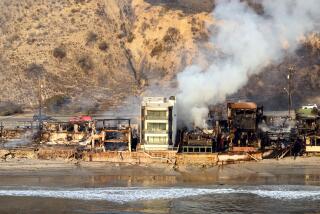U.S. Experts Question Design, Materials : High-Rises in Mexico--Many Not Up to Code?
- Share via
Many of the high-rise buildings that collapsed in the Mexico City earthquake may have been built without strict enforcement of earthquake building codes or high-quality engineering and materials, U.S. engineers said Friday.
Buildings constructed without such safeguards were the most likely to tremble, give way and then “pancake” under the force of the 7.8 earthquake that struck Mexico’s coast and rumbled inland, jostling the soft lake bed that serves as an unstable foundation for the nation’s vast capital, the engineers said.
Even though Mexico’s construction codes are considered to be as earthquake-conscious as California’s, the engineers expressed skepticism about the enforcement of those codes.
“I expect we’ll see a repeat of the lessons we’ve learned from previous earthquakes: That a concrete frame building, if it is not well designed, detailed and constructed, is highly vulnerable,” said Nicholas Forell, a San Francisco structural engineer who researched two major earthquakes that hit southern Mexico in the late 1970s.
Stricter code enforcement--as well as a tougher geological makeup--means that Southern California can be expected to fare somewhat better than Mexico City did when the Big One hits here, as is expected, quake experts and city officials said. Seismologists say that there is a 1% to 2% chance each year of a major quake striking along the lower San Andreas Fault.
Los Angeles’ skyscrapers, many equipped with special hydraulic systems in their foundations, are engineered to allow them to sway but not collapse in earthquakes that register over 8.0 on the Richter scale, experts say. By comparison, the Mexico City quake measured 7.8. The greatest danger is posed by thousands of older buildings constructed of unreinforced masonry.
At a press conference in the Emergency Operations Center in City Hall, Mayor Tom Bradley and other officials sought to reassure residents that the city is prepared if a major earthquake should strike the city.
“We’re doing everything we can to upgrade and improve our ability to respond,” Bradley said. “We always hope that day never comes, but if it does, we are well prepared.”
Frank Kroeger, general manager of the city’s Department of Public Safety, also said the scene of crumpled buildings in Mexico City should not alarm Los Angeles residents.
“With our newer buildings in the city of Los Angeles, we can have a much higher feeling of confidence of those buildings being able to perform (better) than those buildings in Mexico City,” he said.
Kroeger said the greatest concern was for 8,000 unreinforced masonry buildings built before October, 1933. Those buildings, which house about 100,000 workers and residents, are considered the most vulnerable to collapse during an earthquake because their bearing walls are not reinforced.
A City Council ordinance in 1981 called for new standards that would strengthen the old buildings by anchoring the walls with steel bolts through exterior walls and into the roof and floors and then undergoing a more thorough structural reinforcement.
Officials at the city’s earthquake safety division said that since that ordinance took effect, about 2,200 owners of such masonry buildings have been notified about the need to comply with the new earthquake safety standards.
About 670 of those buildings have had wall anchors installed, 255 have fulfilled the reinforcement requirements and another 150 have been voluntarily demolished, according to city officials.
Phil Kaainao, assistant chief of the city’s earthquake safety division, said it will probably take another decade before all 8,000 buildings are in compliance.
More than 4,700 of the masonry structures are commercial and industrial buildings, but they also include some churches, theaters, apartment buildings and historical sites such as the downtown Bradbury Building, which is currently being reinforced.
The officials at the news conference--which included police and fire representatives--said a coordinated plan has already been tested in the event of an emergency. (The operations center had been used in a 1981 flood and was mobilized for the Olympics.) And officials were confident that they could respond quickly and effectively to an earthquake.
Contrasted with the Mexico City quake, a tall skyscraper may be one of the safer places to be if a major temblor strikes Southern California.
Henry Degenkolb, head of a San Francisco engineering firm, said a simple television viewing of the destruction in Mexico City revealed that construction shortcuts were taken in some instances. ‘You could see reinforcement bars sticking out without the ties,” he said, refering to the metal bands that are used to help hold steel-reinforced concrete columns together.
Forell speculated that the skyscrapers that collapsed in Mexico City may have been weakened by those previous temblors--a 7.8 quake that centered in Oaxaca in November, 1978, and a 7.6 quake in Guerrero in March, 1979.
Engineers hope that the quake will provide vital information on how buildings are affected by massive temblors. William Haas, chief financial officer of Kinemetrics in Pasadena, said a series of instruments was installed along the exact path of the quake by the firm and UC San Diego and the University of Mexico only a month ago.
The data will be able to tell building engineers “at what point in (the earthquake’s) acceleration the building cracked,” he said. “One of the hopes from this is that they can learn more about building techniques and can also help engineers and architects to determine after an earthquake, ‘Where should I start looking in the structure for this failure,’ the hidden type of damage that may not be apparent.”
More to Read
Sign up for Essential California
The most important California stories and recommendations in your inbox every morning.
You may occasionally receive promotional content from the Los Angeles Times.










